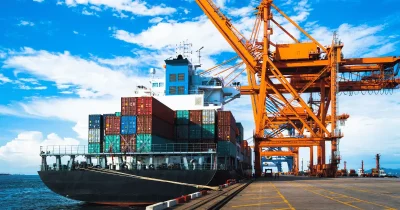According to the National Retail Federation (NRF), the global supply chain is undergoing a transformation. Imports surge on the West Coast, while East Coast routes face labor-related disruptions.
Despite these challenges, US ports are adapting to the tumultuous trade environment. Speaking to The Loadstar, Weston LaBar, chief spokesperson for SVP Industry Relations, predicts “a perfect storm” in shipping.
US ports pivot amid supply chain crisis
While Global Port Tracker has not confirmed December figures for US ports yet, approximately 1.89 million TEU (twenty-foot equivalent unit) imports were recorded last year. This is an increase of 9% when compared to December 2022.
TEU is a standard measure to indicate the capacity of container ships and terminals. One TEU represents the dimensions of a standard twenty-foot long cargo container.
West Coast’s shipping and import surge
The perfect storm LaBar warns of, ties in with the growing volume of cargo handled by West Coast ports. This is largely due to disruptions along East Coast routes and in the Gulf of Mexico.
Trade from West Coast ports had previously declined, losing ground to their competitors on the East and Gulf Coasts. Due to labor contract negotiations on the East Coast, the situation is reversing.
As a result, West Coast routes are now reporting a massive spike in imports. LaBar notes that this surge is driven by “bullish ocean carriers.” As ports adjust, route congestion could likely lead to further disruptions later on.
Despite these challenges, US ports are equipped to handle the surge. LaBar says this is due to recently completed infrastructure projects in preparation for shipping volume spikes.
ALSO READ: Red Sea crisis: Australia recalls livestock ship
Disruptions on East Coast routes
Potential disruptions due to labor negotiations on the East Coast could impact ocean freight rates. As reported by CNBC, new ocean freight contract rates went into effect on January 15.
In addition, disruptions in the Middle East have caused shipping companies to reroute their vessels from Egypt’s Suez Canal around the Cape of Good Hope – adding two to four weeks to their trips.
Earlier this month, Maersk, Hapag Lloyd, CMA CGM, and other shipping giants diverted their vessels. Maersk cited safety reasons for the reroute, adding that “future services would also be the subject of a security evaluation to determine necessary contingencies”.
Another challenge along East Coast routes stems from the post-holiday season slowdown. The NRF quotes Hackett Associates Founder, Ben Hackett, who says shippers must adjust their supply chains “to cope with longer transit times.”
These disruptions have led carriers to cancel their trips and adjust routes, with the potential for further rate adjustments in the future.
NOW READ: Red Sea: What’s happening to the shipping and logistics business?
Share this article
About the author
Cheryl has contributed to various international publications, with a fervor for data and technology. She explores the intersection of emerging tech trends with logistics, focusing on how digital innovations are reshaping industries on a global scale. When she's not dissecting the latest developments in AI-driven innovation and digital solutions, Cheryl can be found gaming, kickboxing, or navigating the novel niches of consumer gadgetry.














